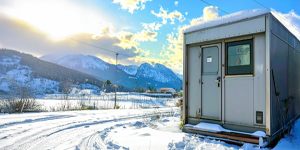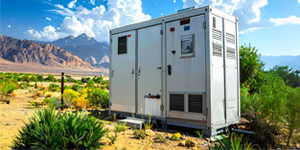

Access hardware used in industrial settings—such as latches, hinges, handles, and fasteners—must increasingly endure punishing conditions. Across industries like HVAC systems, heavy trucks, and industrial enclosures, companies are demanding components that survive extreme environments and heavy use.
This trend is driven by the need for reliability: as more equipment operates in the field under severe conditions, any hardware failure can halt operations or compromise safety.
In fact, today’s industries rely on technology and equipment in challenging environments, creating a surge in demand for rugged hardware that can ensure reliable performance under stress. Ruggedized access components have become essential in construction, transportation, agriculture, energy, and other sectors where downtime is costly and “failure is not an option”.
Harsher Environments and Higher Expectations
Environmental and operating conditions are growing more intense. Climate extremes are a major factor – for example, 2022 saw record-breaking heat waves in many regions (with Europe experiencing its hottest summer on record), and experts predict such extremes will occur more often.
Equipment cabinets, vehicles, and enclosures now routinely face high and low temperature swings, humidity, water exposure, dust storms, salt spray, ice, and vibration. What used to be occasional conditions are now regular challenges. A 2022 industry analysis noted that “extreme working conditions are not limited to high and low temperatures but also include humidity, wet conditions, direct sunlight, dust, snowfall and ice, altitude, ... and vibration". These harsh conditions demand rugged devices and hardware that are truly fit-for-purpose, built to operate day in and day out without failure.
In sectors like warehousing, manufacturing, transport, utilities, etc., the cost of hardware failure can be substantial – not just the direct downtime costs, but also impacts on customer satisfaction and brand reputation.
Beyond climate, regulatory and safety requirements in many industries are pushing toward more rugged hardware. For instance, outdoor HVAC units and electrical enclosures must often meet strict ingress protection or NEMA enclosure standards to be code-compliant. Heavy trucks and off-highway vehicles require cabin and chassis hardware that holds up to continuous vibration and shock on rough terrain. User expectations have also risen – customers expect “built to last” durability and long service life, even under abuse. All these factors are elevating the importance of ruggedized access hardware.
What Does “Ruggedized” Mean?
When we call a latch, hinge, or device “rugged” or “ruggedized,” we mean it is specially designed to operate reliably under extreme or challenging conditions. In practical terms, a ruggedized access component can withstand things like strong vibration, shocks/impact, wide temperature extremes, water exposure, dust ingress, and corrosive environments without failing. It is not just a marketing term – some specific standards and ratings define levels of ruggedness:
IP Ratings (Ingress Protection):
The IP rating system classifies how well an enclosure or device is sealed against solids (like dust) and liquids (water). It’s typically a two-digit code, such as IP65 or IP67, where the first digit (0-6) indicates protection against solids and the second digit (0-8) indicates protection against water. For example, IP67 means a device is completely dust-tight and can survive submersion in up to 1 meter of water for 30 minutes. High IP ratings (IP65, IP66, IP67, etc.) are common requirements for outdoor and industrial hardware to ensure dust does not intrude and rain or wash-down water cannot penetrate.
NEMA Enclosure Ratings:
In North America, industrial enclosures often cite NEMA ratings (from the National Electrical Manufacturers Association), which define the types of environments an electrical enclosure (or hardware) can be used in. NEMA standards indicate an enclosure’s ability to withstand certain conditions – for example, a NEMA 4X enclosure is designed for outdoor use with protection against rain, splash, hose-directed water, and corrosion (often stainless steel, suitable for marine or wash-down settings).
NEMA ratings correlate roughly to IP ratings for water/dust, but also include additional criteria. Unlike IP, NEMA tests may cover resistance to corrosive agents, oil immersion, or ice formation hatchmfg.com. In practice, if a latch is advertised as “NEMA 4X compliant,” it implies it has a robust seal against water and is made of corrosion-resistant materials (e.g., stainless steel or coated metal) to survive long-term in harsh outdoor or chemical-exposed environments.
Corrosion Resistance Standards:
Rugged hardware must resist rust and degradation over the years of exposure. Salt spray testing (ASTM B117) is a common way to validate the corrosion resistance of coatings and materials.
For instance, a typical zinc-plated steel part might only last ~96 hours in salt fog before showing rusten wikipedia.org, whereas truly ruggedized hardware often uses advanced platings or stainless alloys that achieve 500, 1,000 or more hours in salt spray without significant corrosion. Many high-grade fasteners and latches now “pass standards set for 1,000 hour salt spray testing”, making them ideal for wet and corrosive environments.
In essence, a rugged component will use materials like 316 Stainless Steel, protective coatings, or polymers designed to withstand chemicals, moisture, and UV exposure for extended periods.
Vibration and Shock Resistance (Mechanical Durability):
Ruggedized access hardware is built to tolerate constant vibration (e.g. on a truck or machine) and sudden shocks (impact or drops). Standards like MIL-STD-810 (a U.S. military standard) define lab tests for vibration, shock, and other environmental stresses. MIL-STD-810G in particular includes a battery of tests simulating temperature extremes, low pressure (altitude), thermal shock, fungus growth, freezing, and, of course, vibration and shock.
While originally for military gear, these standards are often used as benchmarks for civilian industrial hardware as well. In automotive and heavy truck applications, manufacturers may have their own vibration test specs (similar in spirit to MIL-STD) to ensure, for example, that a door latch won’t loosen or fail after millions of fatigue cycles on rough roads.
A truly rugged latch or hinge will have reinforced construction (e.g., robust springs, pins, or dampers) and may be certified to such vibration test criteria, meaning it stays functional and secure after prolonged shaking that would wear out normal hardware.
Ingress, Corrosion, Vibration Combined:
Often, to be considered fully “ruggedized,” hardware must meet multiple standards – for instance, a heavy-duty enclosure handle might be rated IP66 (dust-tight, high-pressure water resistant), NEMA 4X (outdoor corrosion-resistant), and tested to MIL-STD shock/vibration. Many rugged devices explicitly advertise compliance with these standards (e.g., “IP65/IP67 compliant” or “meets MIL-STD 810G”), giving engineers confidence that the part can handle the specified abuse.
By adhering to these standards, manufacturers ensure that rugged access hardware truly lives up to the definition – operating reliably where standard components would fail due to environmental stress.
For example, a standard zinc latch might seize or rust after a few rainstorms, whereas a ruggedized stainless latch with proper seals can function for years outdoors. Similarly, an unhardened plastic handle might crack in extreme cold or under impact, whereas a rugged one made from fiber-reinforced composite could survive a drop or a heavy pull. In short, ruggedized components are “built to last” in harsh environments, by design.
 |
 |
Failure Points and the Cost of Not Ruggedizing
What are the risks if the hardware is not rugged enough for its environment? The obvious answer is component failure – a latch might break, a seal might leak, or a hinge might seize. But the consequences of these failures can be far-reaching and expensive:
Unplanned Downtime
If a critical door or panel cannot be opened (or closed) due to a broken latch, or if an equipment enclosure leaks water onto sensitive controls, operations can grind to a halt. Unplanned downtime in industrial settings is extremely costly. Estimates show unplanned downtime costs industry ~$50 billion annually, and importantly, equipment failure is responsible for 42% of that downtime.
In other words, nearly half of unplanned outages are due to something breaking. Small hardware components can cause big problems – for example, a $5 cheap latch failure could shut down a machine that costs $100,000 per hour in lost production. This disproportionate impact makes the reliability of every part, including access hardware, critical.
Safety and Liability
In many cases, rugged hardware is a safety issue. Imagine an electrical switchgear cabinet in a factory – if its door seal fails and moisture enters, it could cause a short or even an arc flash. Or on a heavy truck, if a hood latch fails at highway speed, the hood could fly open, causing an accident.
Using under-spec hardware in harsh conditions can lead not only to equipment damage but also injuries or regulatory penalties. That’s why “don’t risk equipment failure” by skimping on enclosures and hardware is a common refrain in engineering guides.
Higher Life-Cycle Costs
While ruggedized components often cost more upfront, they pay off by avoiding frequent replacements, repairs, and failures. Conversely, using cheaper or non-rugged parts can incur hidden costs down the line.
One industry blog succinctly notes that despite higher initial cost, rugged technology’s durability reduces the need for frequent replacements and repairs, leading to long-term savings and more uninterrupted operations.
Similarly, a logistics study highlighted lower operating costs as a key benefit: the savings on repairs and part replacements make rugged devices a cost-effective choice over time.
In essence, you might pay twice if you try to save money with non-rugged hardware – you pay for the cheap part, then pay again when it fails prematurely (not to mention the cost of downtime or damage it causes). Many companies have recognized this trade-off, which is helping drive the trend toward rugged specs even in commercial products.
Failure of Seals/Ingress Protection
A common failure point in harsh environments is water or dust ingress due to inadequate seals or ratings. For instance, an outdoor HVAC access panel that isn’t properly gasketed might allow rainwater in, leading to electrical shorts or corrosion of internal components. Water ingress in electrical assemblies can even create fire hazards or total equipment failure if not mitigated. Ruggedizing the access hardware (using better gaskets, compression latches that ensure tight sealing, etc.) significantly reduces these risks. Similarly, dust ingress in a construction vehicle’s control box can foul up electronics or mechanisms; ensuring all access points are at least IP65 (dust-tight) keeps the internals clean over years of use.
Corrosion and Degradation
If materials are not chosen for the environment, corrosion can eat away at the hardware. Rusty hinges or latches can seize up, or in worst cases, structural parts can fail. A classic example is road salt in northern climates corroding vehicle and enclosure hardware. Rugged hardware counteracts this via Stainless Steel and advanced coatings. For example, a Zinc-Nickel plated latch that passes a 1,000-hour salt spray test will last orders of magnitude longer in the field than a basic zinc-plated one fastenersuperstore.com. Not investing in corrosion resistance can mean costly maintenance: crews having to frequently replace rusted parts, or entire panel doors needing replacement due to frozen hardware.
All of these failure modes have direct and indirect costs. Unreliable hardware creates repair costs, production losses, safety incidents, and reputation damage (if customers face equipment that doesn’t hold up) according to tandeltasystems.com; itsupplychain.com.
It’s telling that many companies now perform hazard assessments for extreme conditions on their equipment, extending not just to worker safety but also to the machinery and tools workers use – this includes evaluating whether devices and hardware will survive events like extreme heat waves, cold, or dust.
The conclusion is often that standard off-the-shelf components don’t make the grade under these stresses. Thus, the demand for robust, ruggedized access hardware is rising as a preventive strategy: it minimizes potential failure points and ensures operational continuity in rough conditions.
Ruggedization by Design: A Systems Approach
To truly achieve reliability in harsh environments, engineers must take a systems-thinking approach to access hardware. This means considering the entire assembly and usage context rather than just individual components in isolation.
For example, suppose you’re designing an industrial enclosure for a mining site: it’s not enough to pick a “rugged latch” and call it a day. You must ensure the door, hinges, latch, seals, and even mounting hardware all work together to meet the environmental requirements.
One weak link can undermine the whole system’s ruggedness – a waterproof latch won’t help if the panel it’s attached to flexes and breaks its seal under vibration. Consequently, leading hardware suppliers like ALLEGIS CORPORATION emphasize early collaboration and a holistic design process for rugged access systems. Rather than selling just a part, they focus on how each component contributes to the overall durability, safety, and performance of the end product.
|
|
Key aspects of a systems approach to rugged hardware include: |
|
Material and Finish Compatibility - Every piece (from latch body to mounting screws) should resist the environment (no point using stainless latch but ordinary steel screws that will rust). Allegis, for instance, might guide a customer to use all corrosion-resistant materials and compatible finishes to avoid galvanic corrosion in a harsh setting. Seal Integrity Across the System - The gasket on a door and the compression force from a latch must be designed together. Using a high-IP-rated latch without an appropriate gasket or vice versa yields little benefit. A systems view ensures the enclosure achieves, say, overall IP66/NEMA 4X as an assembly, by selecting the right handle, gasket, hinges, and even placement of drain holes in concert. Vibration Isolation - In heavy equipment, it may be wise to incorporate damping elements or choose hardware with anti-vibration features (like lock washers, nylon inserts, or self-loosening prevention designs). System thinking might involve testing the entire door assembly on a shaker table to see if anything works loose, then tweaking the design (perhaps adding a secondary catch or using a different hinge type) to solve it. Thermal Expansion and Mechanical Stress - In extreme temperature swings, different materials expand differently. A systems-oriented design will account for this (for example, slotting mounting holes to allow movement or choosing a latch with some flexibility) so that the hardware doesn’t bind or gap when temperature changes. It’s not just the spec sheet of one part, but how it interacts in the assembled state that matters. |
Summary
By engaging with an expert partner at the design stage, manufacturers can ensure these considerations are addressed early. ALLEGIS CORP. helps clients design integrated access hardware solutions that meet ruggedization criteria rather than just supplying components. The result is hardware that is “built to withstand” the environment intended for use and, as a cohesive system, providing reliability that end users can trust.
This approach ultimately supports the campaign theme: showcasing how state-of-the-art access hardware, designed with a holistic mindset, is rising to meet the demands of today’s harsh world.







